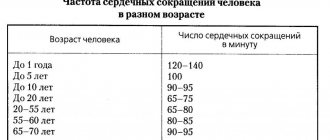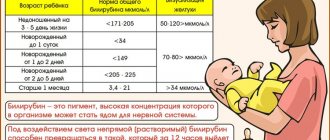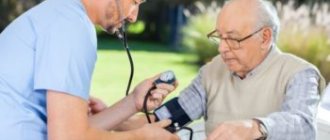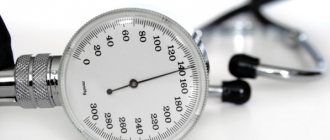Read in this article:
- Why does the heart rate slow down?
- Causes of decreased heart rate
- Types of bradycardia
- Symptoms of low heart rate
- Diagnostic measures
- Actions when your heart rate is low
- Prevention of bradycardia
- Bradycardia can be dangerous
Pulse is considered one of the main biomarkers of the human body. This indicator allows you to assess the condition of the body and the quality of the cardiovascular system. A heart rhythm disorder in which the heart rate slows down is called tachycardia.
Why does the heart rate slow down?
Bradycardia - what is it from a physiological point of view? When the heart beats, its two atria contract first, sending blood into the ventricles. The two ventricles then contract, resulting in blood being pumped into the aorta. From this large vessel it spreads to all tissues and organs.
A special conduction system is responsible for the contractions of the heart. Its work is regulated by the sinus node, located in the wall of the right atrium. It is what slows down the heart rate when a person sleeps and increases it during physical activity. From the sinus node, the impulse is transmitted to the atria, causing them to contract, and then to the ventricles. A decrease in heart rate occurs due to failures at one of these stages.
How to increase your heart rate at home
If bradycardia occurs rarely and is not accompanied by unpleasant symptoms, you can try to reduce blood pressure and normalize the pulse using folk remedies without resorting to medications. To increase the effectiveness of these remedies, it is also necessary to adjust your lifestyle and physical activity.
On average, the heart beats 60-70 times per minute, and if the number of beats per minute in a person is less than 50, then they speak of bradycardia.
Physical activity is a great way to increase your heart rate - walking, jogging, or cycling will do. Regular exercise helps increase the endurance of the heart muscle. In professional athletes, bradycardia is a normal condition - the heart is so adapted to high loads that at rest, one might say, it rests. But bradycardia with hypertension is of a pathological nature.
It is known that the pulse increases in warmth, so hypothermia should be avoided, and to increase cardiac activity, you can drink a hot drink or take a hot bath. To increase your heart rate, it is useful to actively massage your earlobes - this improves microcirculation and reflexively leads to an increase in heart rate.
Some spices increase your heart rate without affecting your blood pressure. A pinch of cinnamon, cloves, and nutmeg will diversify the taste of the dish and help with bradycardia. Cumin, mustard, and hot pepper have similar properties (but you need to be careful with hot spices, they can affect blood pressure).
Cocoa in small quantities is very useful and helps in the fight against bradycardia - you can easily make a tasty drink: add cocoa powder to water or milk, boil and add sugar to taste. Instead of cocoa, you can take dark chocolate, a few slices of which will be enough for an even and full pulse.
Some herbal infusions help increase your heart rate. One of them is a decoction of yarrow. To prepare, you need to take two teaspoons of crushed yarrow herb and pour a glass of boiling water, then leave for 2-3 hours. When the infusion has cooled and been filtered, it must be taken 4 times a day when the pulse drops.
Physical activity is a great way to increase your heart rate - walking, jogging, or cycling will do. Regular exercise helps increase the endurance of the heart muscle.
Peppermint tea acts in two directions - it has a relaxing, sedative effect on the body and nervous system, while reducing blood pressure and normalizing the pulse. To do this, add lemon juice to sweet mint tea. In this case, lemon also acts as a universal medicine against a rare pulse - you can eat it on its own, with sugar, drink its juice and add it to drinks. If you do not have diabetes, you can make a mixture of lemon zest, crushed nuts and honey, which is consumed in the morning and evening. This product invigorates and increases your heart rate.
Often, for bradycardia, mustard plasters are recommended on the chest, approximately in the area of the heart (to the left of the sternum). Burning, warmth and irritation of the skin leads to increased innervation and the body's response is to increase the heart rate. The exposure time of mustard plaster should not exceed 2 minutes.
Using homemade tonic tinctures on fir cones or wild berries can be effective.
The best way to raise the heart rate of a healthy person is physical activity.
Causes of decreased heart rate
The lower limit of normal heart rate is 60 beats per minute. If the indicator falls below this value, this is usually associated with pathological conditions. Low heart rate can only be considered normal for trained athletes.
In other cases, the causes of decreased heart rate are divided into several groups:
- Extracardiac – diseases not related to the work of the heart;
- Organic – arising against the background of cardiac pathologies;
- Toxicological – caused by intoxication of the body;
- Physiological.
One of the most common causes of slow heart rate is a disturbance in the production of impulses in the sinus node. This happens with myocardial infarction and myocarditis (inflammation of the heart muscle), poisoning and hormonal imbalance. In this case we are talking about sinus bradycardia.
Noncardiac causes of low heart rate include cardiac ischemia, cardiomyopathy, heart failure, and heart defects, both acquired and congenital. Other diseases that cause such manifestations include:
- Severe infections, such as meningitis or diphtheria, typhoid fever or hepatitis;
- Anemia;
- Pathologies of the endocrine glands - diabetes, dysfunction of the adrenal glands or thyroid gland;
- Vegetovascular dystonia;
- Respiratory diseases - asthma, bronchitis.
Toxicological factors can lead to low heart rate. These include uncontrolled use of medications, such as heart stimulants or diuretics. The same applies to the use of alcohol and drugs, smoking, and any acute intoxication of the body. The pulse may decrease due to a lack or excess of sodium, magnesium, potassium, and calcium ions in the body.
As for physiological factors that can cause a slower heart rate, these include prolonged exposure to low temperatures, hormonal changes in adolescents, general fatigue of the body, and slower metabolism in older people.
Diagnostics
Measures to eliminate the increase in heart rate should be taken immediately when symptoms are detected. Before prescribing treatment, the doctor will conduct a detailed examination, collect anamnesis, and find out whether any of the patient’s family members suffered from cardiovascular pathologies. To determine why the pulse fluctuates despite normal blood pressure readings, a comprehensive diagnosis is needed.
The recommended list of examinations includes:
- general blood tests and for biochemical composition - here signs of chronic inflammation in the body, lack of hemoglobin and other problems may appear;
- ECG – to assess the functioning of the heart;
- taking blood for analysis of hormone levels - allows you to identify incipient diseases of the endocrine system;
- daily monitoring of blood pressure and heart rate to record the time of increase in pulse and the conditions predisposing to it;
- Ultrasound of the heart;
- Ultrasound of the abdominal organs, liver, kidneys.
Performing an ultrasound of the heart
If consultation with additional specialists is required, the patient is referred to a neurologist, endocrinologist, or ENT doctor, depending on the root cause of the signs of arrhythmia.
Types of bradycardia
There are several types of bradycardia:
- Absolute – with a steadily reduced heart rate, which does not increase even with physical activity;
- Relative – the pulse increases in proportion to the degree of load or against the background of infectious diseases;
- Moderate - at rest, the pulse does not exceed 40 beats per minute.
Even if a decrease in heart rate does not bother a person or cause any discomfort, it is necessary to identify the cause of such changes in order to prevent the risk of dangerous complications.
The dangers of low blood pressure and high pulse
Hypotension in combination with tachycardia is very dangerous. This symptom not only causes weakness of the heart muscle, but also leads to constant shortness of breath, weakness, and decreased performance.
A malaise that many do not take seriously leads to:
- heart attacks and strokes;
- Alzheimer's disease;
- ischemia;
- dementia.
Often such health problems end in death.
The best prevention of high heart rate with low blood pressure is a healthy lifestyle, sufficient physical activity, regular contrast showers, and the presence of foods high in potassium and magnesium in the diet.
If problems cannot be avoided, do not postpone your visit to the doctor. A timely and correctly drawn up treatment regimen will help avoid disastrous consequences and restore health.
Symptoms of low heart rate
Low heart rate symptoms are signs that accompany a slow heart rate:
- Semi-fainting or fainting states;
- Difficulty breathing;
- Dizziness and weakness;
- Chest tenderness;
- Blood pressure surges;
- Periodic short-term visual disturbances;
- Impaired concentration, memory function;
- Headache;
- Confusion of creation;
- Numbness of the extremities, feeling of coldness in the arms and legs.
With a moderate decrease in heart rate (5-10% of normal), bradycardia may not manifest itself in any way. Symptoms generally appear with a more significant drop in readings.
Diagnostic measures
In order to diagnose bradycardia, the general clinical picture is studied: a person’s lifestyle, his complaints, and accompanying symptoms. A cardiac examination is required to identify possible heart pathologies. The doctor analyzes information about the medications the person is taking and compares the electrocardiogram data with other indicators obtained as a result of laboratory tests and examinations. The classic Holter method or weekly monitoring of the heart rhythm using a special mobile device can be used.
Actions when your heart rate is low
Bradycardia can be dangerous, because with rare contractions of the myocardium and slow blood circulation, hypoxia develops. Oxygen starvation has an extremely negative effect on the brain and causes loss of consciousness. If a person is not given prompt assistance, breathing may stop. This is why it is important to know exactly what to do when your heart rate is low.
Help with a decrease in heart rate depends on the reasons that cause it. If we are not talking about heart disease, you can cope with the problem on your own:
- Take Corvalol;
- Drink 20 drops of motherwort twice a day;
- Take Zelenin drops until the pulse is completely restored (the drug has contraindications: organic damage to the heart, pancreas, vision).
If the pulse decreases due to heart disease or other pathologies, you must call an ambulance. Before the doctor arrives, the person must be positioned so that the legs are higher than the heart. For breast tenderness, you can give nitroglycerin, a fast-acting drug that provides relief in just 5 minutes. Belladonna extract can help with the first attacks of bradycardia, but its effect takes about half an hour.
What to do if your heart rate is high
Causes of increased heart rate may include high physical activity, emotional stress, psychological stress, accumulated fatigue, regular alcohol consumption, smoking, excessive consumption of caffeinated drinks and even overheating in the sun. If the situation is not critical, you can make independent attempts to prevent possible episodes of tachycardia in the future:
- If you experience shortness of breath after minor physical exertion, this is a symptom of a weak heart. To strengthen your heart muscle, exercise 15-30 minutes a day, walk more, and avoid the elevator and escalators.
- Excess weight puts additional stress on the heart, forcing the organ to work even harder, distributing blood to vital organs. To get rid of tachycardia caused by obesity, you should definitely lose weight by giving up fatty unhealthy foods, carbonated drinks, baked goods and sweets.
- Hot spices, coffee, black and green tea can provoke attacks of tachycardia in people prone to such conditions. Replace unhealthy drinks with natural fruit drinks, juices, compotes and clean water.
- Control your salt intake, it retains water in the body, thereby increasing blood pressure and increasing the load on the heart muscle. Of course, you don’t need to completely give up salt; it’s enough to exclude snacks, pickles, and smoked foods from your diet.
No matter how trivial it may sound, an effective method of dealing with tachycardia is to avoid stress and nervous tension; for older people, a strong emotional outburst can result in a heart attack or death.
If you have to regularly deal with stress or are going through hard times, you can take herbal-based sedatives - motherwort, valerian tablets. More serious medications can be taken after consultation with your doctor, and only for a short time.
Prevention of bradycardia
In order to prevent bradycardia, it is necessary to undergo regular medical examinations, and if you have heart disease, follow all doctor’s recommendations. In such cases, it is very important to systematically measure blood pressure and report significant changes to the doctor. By the way, home automatic blood pressure monitors determine not only upper and lower pressure, but also pulse rate, and also record arrhythmia.
A healthy lifestyle helps to avoid the development of bradycardia: an optimal combination of work and rest, proper nutrition, regular physical activity appropriate for age and health.
When to see a doctor?
If you have symptoms of bradycardia and a pulse less than 60 beats per minute, you should consult a physician or cardiologist. The doctor will determine the causes of this condition and prescribe effective treatment.
Not all bradycardia causes symptoms. However, low heart rates cannot be ignored. A repeated decrease in heart rate is the “first bell” that will force the timely diagnosis of heart disease and non-cardiac pathology, and prevent the development of dangerous complications.











